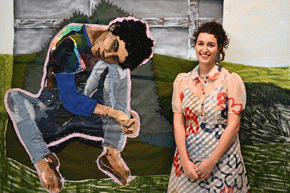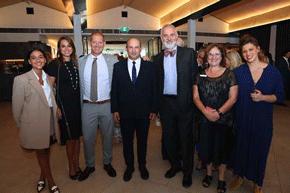Israeli and Palestinian drivers celebrate new road, as critics accuse Israel of ‘apartheid’
Once again, Israel found itself under attack by international media, left-wing non-governmental organizations and the Palestinian Authority, but this time for a different reason—they simultaneously accused the Jewish state of carrying out a policy of apartheid against its Arab population…writes Josh Hasten/JNS.

View of Route 4370, northeast of Jerusalem, which connects the Geva Binyamin area to Route 1, and separates vehicles of Israeli citizens and non-citizens, Jan. 10, 2019. Photo by Yonatan Sindel/Flash90.
The firestorm of allegations followed the opening of a new 5-kilometer (3.1 miles) stretch of highway to the east of Jerusalem, which contains separate lanes for Israeli citizen and non-citizen traffic divided by a concrete wall with a fence on top.
Motorists and Israeli officials, however, are praising the new Eastern Ring road, Route 4370, which bypasses an overtaxed entrance to Jerusalem, as a game-changer that is already alleviating the recurrent and maddening traffic jams in the area.
Jewish and Arab leaders participated in a ribbon-cutting ceremony earlier this month launching traffic on the new road.
In response to the rampant accusations that the segregated road represents a form of apartheid, Rachel Greenspan, senior advisor for foreign affairs and media to Jerusalem Mayor Moshe Lion, told JNS that “this road represents the exact opposite of apartheid, by easing congestion and movement for the city’s Arab residents, especially those in the Shuafat Camp and in Issawiyya.”
She added that “this road will allow Arab and Jewish residents alike to move throughout the city more efficiently, improving day-to-day life for all.”
‘We don’t look at the politics’
One of those in attendance at the ribbon-cutting ceremony for the new road was Akram Abdel-Rachman, a retired business leader in the Jerusalem Arab community and resident of the city’s southern Sharafat neighborhood.
When asked why he backed the new route while others, including the Palestinian Authority leadership criticized it, Abdel-Rachman told JNS that he supports “any project that eases the life of residents in the area. It’s a blessing.” He explained that “today, so many families have multiple cars, and there is so much traffic in the area, what difference does religion make?”
He added, “We are not politicians; we just want quiet here, and the ability to make a living. We don’t look at the politics; we just want services like all residents here.”
In addition to Lion, Minister of Transportation Yisrael Katz, Minister of Internal Security Gilad Erdan were joined by Abdel-Rachman and the mukhtar, or Muslim spiritual leader, of neighboring town of Anata, who specifically wanted to show his approval and appreciation of the project.
Despite support for the new road from local Arab leaders, it is the images of the new parallel roads separated by a barrier that has drawn the ire of international media and other parties who seek to delegitimize the Jewish state’s presence in the contested provinces of Judea and Samaria.
Others view the move as simply a land grab by Israel in Judea and Samaria.
Writing in the left-wing Haaretz daily, Shaul Arieli, considered one of Israel’s leading experts on the demarcation of the future Israeli-Palestinian border, said that while the new road may, in fact, ease travel time for Palestinians, he believes that Israel had an ulterior motive in building it—namely “to pave the way for the construction of the Mevasseret Adumim neighborhood, also known as E1, which was planned to create a continuum of Jewish construction between Ma’aleh Adumim and the capital [of Jerusalem].”
Ultimately, Arieli believes that the new passage is another attempt of the “Netanyahu government’s policy of pushing for annexation” of parts of Judea and Samaria.
The opening of Route 4370 represents the completion of the initial stage of a major transportation project in the northern Jerusalem area—to benefit both Jews and Arabs—that so far has cost around NIS 30 million (slightly more than $8.1 million).
Israel has often come under fire for developing transportation arrangements for Jews and Arabs, whether they are shared or segregated. Palestinians have their own buses and taxis servicing their villages, even within Israeli-controlled territory, while special bus companies including Egged primarily service Jews. When segregated systems are developed, Israel is often accused of apartheid.
Jews and Arabs share West Bank roads

Standing on the new Route 4370 are, starting second from left: Israeli Minister of Transportation Yisrael Katz, Jerusalem Mayor Moshe Lion, Minister of Internal Security Gilad Erdan, the “mukhtar” (Muslim spiritual leader) of Anata and retired business leader Akram Abdel-Rachman. Credit: Courtesy.
Elnatan Scharia, spokesman for the Yesha Council of Jewish communities in Judea and Samaria, explained to JNS, that “Arabs under the P.A. can’t enter Jerusalem [without a permit], so instead of having to get stuck in checkpoint traffic outside the city, the new bypass road [Western spur] allows them to get to places like Jericho more easily.”
He emphasized that despite the misinformation out there accusing Israel of building “Jewish-only” roads Jewish and Arab motorists share all of the main arteries throughout Judea and Samaria, commonly known as the West Bank.
Interestingly, while Arabs can travel freely throughout Judea and Samaria, Jews are limited in which roads they can travel. Under Israeli law, it’s illegal for Jews to enter any territories labeled as Area A, or under full Palestinian Authority security and administrative control. It is illegal to enter, as the IDF is unable to operate freely in these areas even if a Jew is in danger. Large red signs warning Israeli citizens not to enter these areas have dotted the entrances to Palestinian Authority-controlled towns and villages.
The division of land in Judea and Samaria into pockets of Israeli and Palestinian control, known as Areas A, B and C, followed the signing of the Oslo Accords in the 1990s.
Prior to Oslo, Israelis were able to travel freely throughout all of Judea and Samaria, including in major Arab cities, such as nearby Ramallah. At the same time, Palestinians were able to travel freely throughout Israel, with restrictions being introduced for security purposes in 1989, shortly after the start of the First Intifada, and expanded after a wave of deadly terror in 1993 shortly after Oslo was signed.
In the wake of the violence, Israel built an extensive series of roads that bypass Palestinian cities. While the roads provide safe travel for Jewish commuters, they are also used by Palestinian drivers who seek to avoid downtown traffic jams.
All of the major traffic routes, including Highway 60—the main north-south highway extending from northern Samaria to southern Judea—are open to both Israeli and Palestinian motorists.
An ‘oxygen pipe’ for the entire region
Yet according to the project’s partners, including the Ministry of Transportation, the Jerusalem Municipality and the Binyamin Regional Council, there are logical reasons for separating Israeli and Palestinian traffic.
Transportation Minister Katz said that “the paving of the road constitutes an important step in connecting the residents of the Binyamin region to Jerusalem and in strengthening the metropolitan area of Greater Jerusalem.”
The Western spur of the road, which is open for cars with Palestinian Authority license plates, serves as a bypass for Arabs to travel from north of Jerusalem towards Palestinian towns to the east and south of the city without having to stop at any Israeli checkpoints. The eastern spur of the ring road connects Israeli communities north of Jerusalem to the city itself via the checkpoint at the Naomi Shemer Tunnel or the French Hill Junction, both on the eastern side of the city.
The road, therefore, offers drivers another way of getting into the city, bypassing the busy Hizma checkpoint, which connects the Pisgat Ze’ev neighborhood with the rest of Jerusalem.
For years, the checkpoint has been a daily rush-hour bottleneck for both Jews and Arabs seeking to enter the city, as well as for Arabs who don’t have access to the city but need to drive through thoroughfares that previously led directly towards the checkpoint.
Yisrael Gantz, head of the Binyamin Regional Council, described the new road as “nothing short of an oxygen pipe for the residents of Binyamin and the entire region.”









